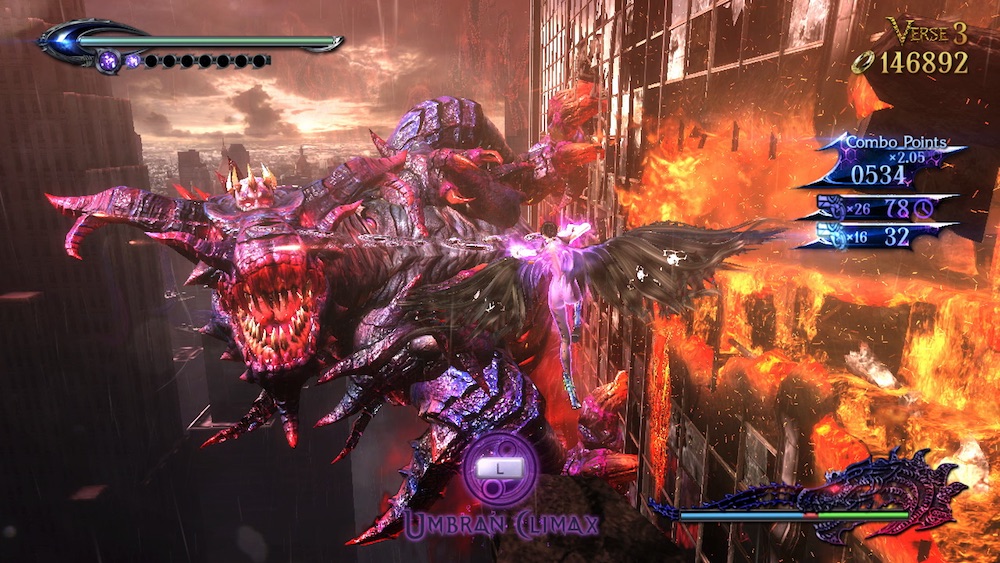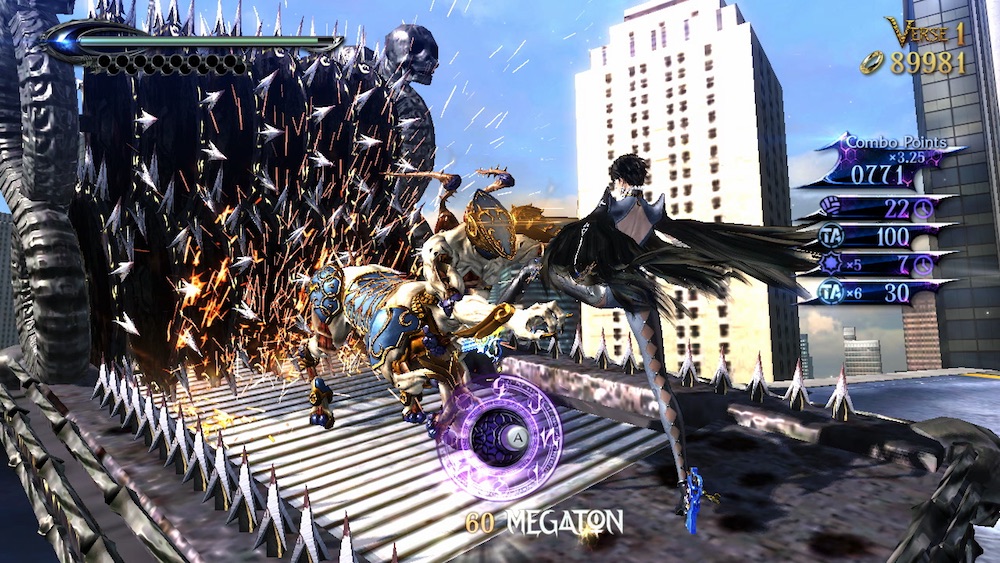
“What would it look like if one witch went to actual hell to save another witch?” “What would happen if we kitted out this irritating dreadlocked kid with an even more irritating voice?” “Would it be beneficial if we shoehorned mechs into this game?” These are the questions that Bayonetta 2, which recently arrived on the Switch (after a life in which it was nearly never released before Nintendo swooped in to make it a Wii U exclusive in 2014), dares to ask. Actually, I have good news: in almost every way measurable or imagined, Bayonetta 2 is a better game than its predecessor.

Let’s start with the graphics because they’re the first thing I noticed. They’ve improved! Environmental details seem a bit finer, and the cutscenes are smoother and more expressive. The whole world somehow has +50% more colour and life in it. I wasn’t particularly expecting this, for some reason, despite the 4/5 year gap between initial releases of the two games which reasonably explains these circumstances. The seedy/voyeuristic bent of the game’s camera also seems slightly toned down – either that or I’ve become inured to it. It sure still has its overt viewer-pandering moments, but they’re less frequent and less jarring, I think. Fortunately, the semi-frequent technical problems seem to have been ironed out as well – I don’t think I noticed being betrayed by bad camera angles mid-fight at all, which is a big step up from the older title.
Bayonetta 2 also has a story that’s relatively engaging from its opening scenes. The primary destination in the game – a mountain called Fimbulventr, which has gates to Inferno and Paradiso and is apparently where some deity used to live – works better as an imaginable, mappable space than the relatively drab and sprawling Vigrid of Bayonetta-the-first. Bayonetta’s main initial goal, to rescue her friend (and fellow witch) Jeanne from Inferno, is a nicely digestible plot device which was sorely lacking last time around. That said, it does (again) end up in a bit of an operatic mess, full of cavernous mythologies, conceptual arguments, everyone fighting everyone else, a whole time-travel section, and ending with a bout of tedious preaching about the righteousness of humanity’s free will. Alas, it also has one unforgivably annoying character in Loki, a child with an unmendable swagger, a tendency to frequently clutch at his head in sudden pain, and a particularly irritating way of calling Bayonetta “love” (here the vocal delivery is even worse than the intention behind it).

The twitchy combat system at the heart of the game has had a couple of tweaks but otherwise is as was: two button combos and evasion for miles. There’s now the welcome option to trigger your magic meter for (what amounts to) demon-abetted extra powerful kicks/punches instead of just the hilarious quick-time-y “torture attacks,” which have limited utility in boss fights. Because of the way the story arcs, you get to fight a bunch of vice-labelled creatures from Inferno as well as many strange angels, some of which we saw last time. A couple of new weapons are in the mix. There’s also a short section where you get in a mech, which hits harder but slower, and is, therefore, I think, not a great addition to a game otherwise all about speed. If you save up enough in-game currency, you can apparently buy one to use whenever you want. Once again, the regular combat sections are padded out with arcade-homage schmup sequences, although here too the developers seem to have learned a bit, and they aren’t quite so long or repetitive.
Like in the first Bayonetta, the boss fights are plentiful, extravagant and a good workout, if not quite as off-the-rails (at least, there isn’t the near-endless procession of them to close out the game which Bayonetta-the-first had). I did take issue with some of these, with a few bosses having an array of tricky attacks with varying timings, all cued by the same initial motion, making them extremely difficult to dodge correctly. These boss-fights were perhaps the one area the game felt kind of unfair rather than a good test of skill, and I found getting through them became a matter of brute forcing with luck, guesswork and lots of healing items.

There are a couple of other design issues I picked up on (which could perhaps be just as applicable to the first Bayonetta, except that I only noticed them this time). I found playing the game in handheld mode on the Switch gave me hand cramps, particularly during more intense button-mashing sections. I probably didn’t pick this up last time because after the first few chapters I played most of it on the TV. Whether this is a problem with me or the handheld shape being not ergonomic enough, I don’t know. And although Bayonetta-the-first had collectables, I felt much more aware of them this time, enough that I was compelled to explore the game looking for them at points. But this creates an unwelcome tension in Bayonetta 2 because although the environmental layering is an improvement on the original, it still contains a lot of invisible walls and inconsistent spaces. There’s often no visual difference between places you can get to and parts that are sealed off, which becomes a problem when the game is trying to reward you for prodding around the edges.
I also feel compelled to mention that Bayonetta 2 has a weird little competitive co-op mode, in which you head into a practice arena with someone else to fight small waves of enemies and see who can get the best score. So there, I’ve mentioned it. You know that I know that it exists. I don’t think it has much use, aside from potentially providing an avenue for someone struggling with the single-player story to earn some currency and thereby make life easier for themselves. I wish there were an actual, story-based co-op here instead, although I can see why that might be a bridge too far for the developers.

Bayonetta 2 is an all-round improvement on the-fun-but-flawed Bayonetta, which I guess is exactly what you’d want from a sequel. It’s visually sharper and technically smoother. It feels just slightly less seedy to participate in, and it has a more coherent (but still convoluted and far-reaching) story, with basically the same combat experience that was the boon of Bayonetta-the-first. Despite all this, in my heart of hearts, I can only tentatively give it the green light for this, a consumer review. It’s a bit like junk food: enjoyable moment to moment, but after nearly 30 hours of the franchise, I feel bloated and tired, with no desire to dive back in for a second go anytime soon. Maybe with some distance, I’ll feel differently.











